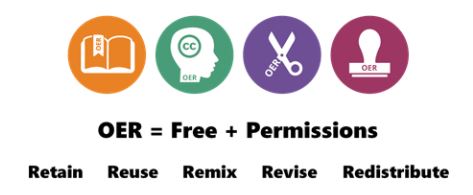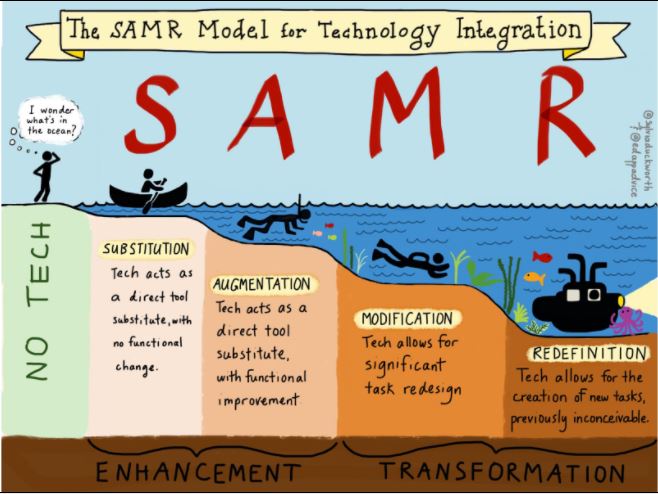As the semester draws to a close, I wanted to collect a few of the many takeaways from the course in one place, and highlight the things I’m going to be carrying with me into the future and my teaching career.
What/So What/Now What; this reflection framework is so simple, but so incredibly valuable. Our job as educators isn’t just to provide information. If students were motivated, they could find pretty well any information they wanted, and that’s especially true for most high school content areas. What’s quickly become invaluable in our society is the “So What” and “Now What,” examining what impact/relevance learning has on the daily lives of ourselves and those we care about, and what we’re inspired/going to do now that we have a better understanding of the forces at play around us. The question isn’t what our students know, but what they can do with what they know, and this is an awesome way to get them thinking along those lines as often as possible.

Open Educational Resources; we’ve been introduced to tens of databases and collections for academic and non-academic resources, that can be used and licensed either without restriction, or with minimal restriction. Not all of them can be utilized totally flexibly, but many certainly can, and all can be accessed without having to pay out-of-pocket. Open Educational Resources are a signpost for what I want the future to look like; cooperation and dissemination of information driven by bettering ourselves and each other, rather than financial gain. I do believe that the creators of these resources deserve some compensation for their time and effort, and so Teachers Pay Teachers is one thing I will frequently utilize, but my longer-term hope is that community and shared responsibility will be elevated above consumerism and economy, and open educational resources may one day stand as a great milestone to that end.

The Substitution/Augmentation/Modification/Redefinition (SAMR) Model; I believe that mindfulness is the single most limited resource when it comes to technological development, innovation, and implementation, and this model is another simple way to encourage thinking beyond immediate facts. I think so much technological “advancement” has asked the question “can we” but not the question “should we,” and this model provides that missing step. Technology has moved faster than we can accurately assess its impacts, but if we can be deliberate and mindful with how we use it, we may find that that rate slows down, or at least, that we exhibit enough caution that the negative impacts we’re starting to see arise are mitigated. It’s also important to remember that we don’t have to redefine everything we do. The name of the game is providing a deeper, more engaging, more comprehensive learning experience, and if a given technology isn’t being used to that end, I’m not using it until it can be.
EdCamps; I think EdCamps are terrific and relatively easy ways to discover what students are passionate about, what they hope to learn about, and what lines they already think along. There is so much that I as a teacher can learn by giving students space to discuss topics they care about, and listening to that discussion, and I can take that and pour it back into our classroom to further develop their understandings, thought processes, and general ability to navigate the world.

Inquiry-Based Learning; inquiry is one of the most powerful processes humans are capable of, and I have a great desire to give my students the time and opportunity to ask questions and learn how to find the answers, and how to apply them. However, inquiry is only effective when the students are capable of doing it, and the four levels of inquiry that Trevor MacKenzie discussed with us are a terrific starting point. It’s important to remember that no form of inquiry is inherently “better” for learning than any other one, and they all have different contexts and situations where they are the most effective form. Furthermore, sometimes inquiry will be less effective learning than other forms, and so we need to constantly assess what our students are capable of, how much direction they need, and whether we’re actually helping them to develop life-relevant skills or not.
Accessibility; technology is so, so powerful for creating equitable environments where all learners can participate in education, and we forget about that because the technology we always hear about is predominantly commercial. I may not always have the budget to support students with the technology I would like to, but mindfulness is again the name of the game. The smallest steps can still make a big difference in a student’s experience, like always having captions on videos/images, presenting information in multiple forms, and providing space for students and families to voice their needs and supports. The barriers that stand in the way of student learning may not completely disappear in my classroom, but I hope they are at least more manageable, and that my students have the hope and belief that they can be surmounted.
I could go for pages and pages, but I’d just be coming back to the same basic principles. Mindfulness. Community. Support. Personal Growth. As a human being that also happens to be an educator, these are what are most important to me, and what I believe are most important to my future students’ future wellbeing. They may feel differently, and they’ll have the space to say so, and to explore their own beliefs and visions for the future. It’s going to be a wild ride, but I think it’s going to be a lot of fun.
Cheers,
Kinnon Haufe
Photo by Jermaine Ee on Unsplash

Leave a Reply
You must be logged in to post a comment.